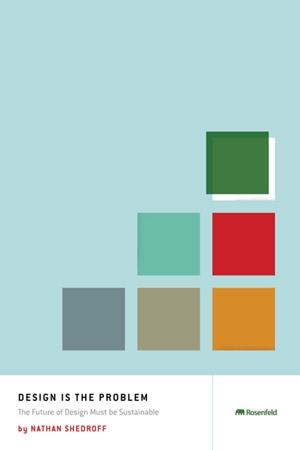This post was submitted by guest contributor and author Nathan Shedroff. In his book, Design is the Problem (released March 2009), Nathan explores one of the most interesting sustainable design strategies available to product developers.
When people first approach sustainability, it can be a confusing and frustrating experience. There are so many voices, and so many perspectives that can seem to contradict each other. My own experience in earning an MBA in Sustainable Management was like that until the end of the second year.
There are many pundits who claim to have the answer and many frameworks that are positioned and promoted as the best. But they seem to have only partial solutions and sometimes they even contradict one another. In my experience navigating this world, I’ve come to the following conclusion: they're all valuable because they provide an important piece – albeit partial – of a much larger picture.
Of the eight major sustainability frameworks I found (you’ll find them all in my book), no one framework completely covers the spectrum of environmental, social, and financial issues. Some are quantitative, others qualitative (though, with a notable lack of standards, all of them feel more qualitative at the moment):
Quantitative frameworks:
- Life Cycle Analysis
- Datschefski's "Total Beauty"
- Social Return on Investment (SROI)
Qualitative frameworks:
- Natural Capitalism
- Natural Step
- Cradle to Cradle
- Biomimicry
- The Sustainability Helix
Reviewing these frameworks, even on a cursory level, can help designers, engineers, and managers understand the full spectrum of issues, and then define for themselves what sustainability demands My favorite definition to date is simply: don't do things today that make tomorrow worse.
Without delving too deeply into a list of why sustainability is important (and the list is long), developers can quickly put sustainability to work by reviewing a short list of strategies that apply to all products and services:
- Design for use - make things that truly improve people's lives, give them meaning, and are usable and useful to them.
- Dematerialization - reduce the material and energy used in the manufacturing, use, recycling, and disposal of products and services.
- Materials and energy substitution - substitute more sustainable and less toxic materials and energy.
- Localization - design solutions and systems to reduce material and energy travel and support local communities.
- Transmaterialization - redesign and deploy products as services that focus on customer value instead of physical things.
- Informationalization - translate solutions into data and send the recipe for the solution, not the solution itself.
- Design for durability - the most sustainable solutions are products that don't need to be quickly discarded or wholly disposed of when one part breaks.
- Design for reuse - intended reuse of products in other contexts can extend product life and divert them from disposal.
- Design for disassembly - clearly marked and easily disassembled products will more likely be recycled.
- Close the loop - systems that create solutions across a myriad of stakeholders are more robust and more sustainable.
- Design for effectiveness - dematerialization and increased efficiency is a great start but there is higher fruit to pick that involves rethinking value.
- Design for systems - transforming systems at higher levels creates the most radical, sustainable change.
There, that's not so hard is it?
OK, it's still a lot to track. I’ll simplify, and close with this much shorter list:
- Create more (value, meaning, and performance) with less (materials, energy, and virgin materials).
- Focus on efficient and healthy alternatives.
- Use and promote local energy, resources and labor to reduce transportation.
- Don't use PVC unless there is no alternative.
- Design solutions that are so good, they are savored.
There’s my entire book in one post – minus the important details, of course. Buy the book to see concrete examples of the principles I’ve listed, and you’ll be on your way to discussing these issues intelligently – and putting them into practice. Armed with a bit more knowledge, you should be able to start asking questions during your development processes and start answering them with better solutions.
Design Is the Problem is now on sale; Sustainable Minds readers can receive a 15% discount by using code SUSTMINDS when entering their purchase at the Rosenfeld Media site.
Image Credit: Rosenfeld Media

